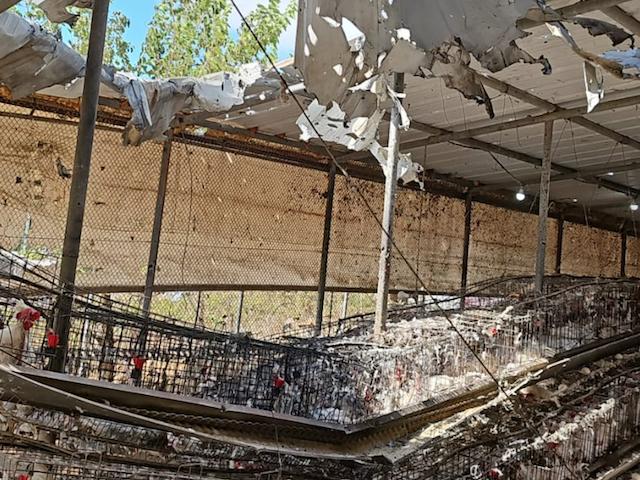In a stark reminder of the ongoing and relentless threat from Lebanon, at precisely 13:40 on Wednesday, the blaring of sirens shattered the midday calm in the region of Shtula, Northern Israel. A single projectile was detected crossing into Israeli airspace from Lebanon, ultimately landing in an open area, sparing lives and property. Yet, this incident was only part of what would become one of Hezbollah's largest and most audacious assault on Israel's North in recent months, one aimed at civilians, and one which destroyed homes and businesses of ordinary Israelis.
The Calm Before the Storm
The Israel Defense Forces (IDF) had spent much of the past day methodically targeting Hezbollah's rocket launchers, particularly those concealed in the Kounine and Qabrikha regions of Southern Lebanon. These strikes were surgical and precise, aimed at neutralizing the terror group's ability to strike Israeli soil. But Hezbollah, undeterred and emboldened, was gearing up for a massive escalation.
Heavy firing of rockets by Hezbollah into civilian homes in the north.
— AMIRAN 🇮🇱 (@Amiran_Zizovi) September 4, 2024
How far can we go on like this? pic.twitter.com/gr1CiMDLI9
A Massive Assault: 66 Rockets in a Single Day
Earlier in the day, Hezbollah unleashed its most significant attack since August 25, a day etched in the collective memory of Israelis as one of the most intense in the ongoing conflict. According to the IDF, the Iranian-backed terror organization fired 66 rockets at Israel, with sirens wailing across 48 different locations in the North shortly after noon.
The scale of this attack caught even the vigilant IDF off guard. It took the military approximately 90 minutes to fully grasp the extent of the barrage, a stark contrast to the past week where the average number of rocket sirens per day rarely exceeded 20. This sudden escalation was a clear signal that Hezbollah had no intention of de-escalating its aggression, despite recent IDF successes.
Video shows one of the homes in Kiryat Arba that was hit by Hezbollah rocket fire in the past hour.
— Jewish News Syndicate (@JNS_org) September 4, 2024
▸ Approximately 60 rockets were fired into Israel according to reports
▸Thankfully, despite several hits on buildings and open spaces, no injuries have been reported at this… pic.twitter.com/Gh9a8KypnI
Hits and Misses: The Battle in the Skies
The sheer volume of rockets posed a significant challenge for Israel's sophisticated air defense systems. While the IDF successfully intercepted many of the incoming threats, a few rockets slipped through, striking areas such as Kiryat Shmona and sparking fires in fields across Malchia, Ramot Naftali, and Beit Hillel. The military's inability to intercept every rocket underscores the complexity and unpredictability of defending against such a massive, coordinated attack.
Hezbollah's Relentless Campaign
This latest barrage is a sobering reminder of the intensity of the conflict that flared on August 25, when Hezbollah launched between 250 to 350 aerial threats in a single day. On that day, the IDF preemptively struck, destroying thousands of Hezbollah’s rockets and preventing what could have been a catastrophic assault involving up to 1,000 rockets. Despite the IDF's strategic victories, Hezbollah remains a formidable adversary, still in possession of approximately 140,000 rockets from its pre-war arsenal of 150,000.
🚨BREAKING: More than 60 rockets were fired by Hezbollah from Lebanon towards northern Israel, in the latest barrage of rockets with numerous direct impacts reported and extensive damage in the area. No physical injuries reported. pic.twitter.com/jiLgOi7EUv
— StandWithUs (@StandWithUs) September 4, 2024
Israel's Response: A Measured Retaliation
In response to the latest escalation, the IDF intensified its counterattacks, targeting the launch sites in Kunin and Kabariha. Despite the increased ferocity of these strikes, the IDF's operations remained confined to Southern Lebanon, a strategic decision likely aimed at preventing further escalation while maintaining pressure on Hezbollah.
Political Tensions Rise: The Debate Over Northern Israel
As the conflict continues, so too does the political debate within Israel. The ongoing evacuation of 60,000 residents from the North has become a flashpoint. Prime Minister Benjamin Netanyahu faces mounting pressure to issue an ultimatum to Hezbollah, demanding a cessation of hostilities to allow for the safe return of these residents. However, Netanyahu has resisted such moves, preferring to keep the focus on dismantling Hamas in the South, even at the cost of prolonging the displacement of Northern communities.
Hezbollah rockets hit yet another chicken coop in the north, this time in Zarit.
— Mark Halawa - مارك حلاوه 🎗️ (@HalawaMark) September 4, 2024
Coward Nasrallah will find out soon that firing dozens of rockets at Israeli communities and businesses will not go unpunished. https://t.co/xnDu5BOKY5
His chief political rival, National Unity party leader Benny Gantz, has been a vocal critic of this strategy. Gantz had previously called for a September 1 deadline, urging Netanyahu to ensure the safety of northern residents in time for the start of the school year. On Wednesday, Gantz renewed his criticism, accusing Netanyahu of "continued hesitations" that have left the North exposed to Hezbollah’s relentless attacks.
Conclusion: The Path Forward
As the conflict drags on, Israel finds itself at a crossroads. The IDF continues to score tactical victories, yet the threat from Hezbollah remains potent and persistent. The political leadership must navigate a complex landscape, balancing the immediate need for security with the broader strategic objectives in the region. One thing is clear: the situation in Northern Israel remains volatile, and the coming days will likely test the resolve of the Israeli government and military like never before.


